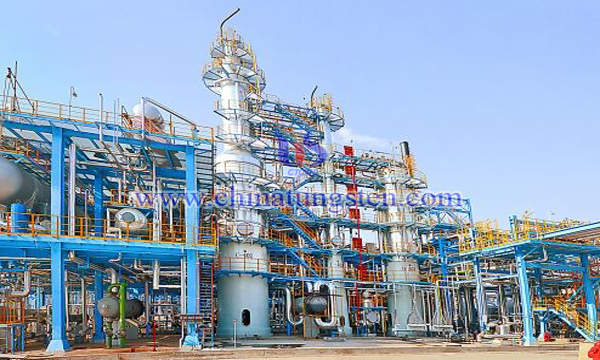Tungstate Oxidative Desulfurization Catalytic Practice
- Details
- Category: Tungsten Information
- Published on Wednesday, 09 January 2019 22:49
With the rapid development of automotive industry, sulfur pollution caused by combustion of automotive fuels is becoming more and more serious. Strict sulfur content standards for gasoline and diesel have been formulated in various countries and regions of the world. Hydrodesulfurization (HDS) is usually used in industry to remove sulfides from gasoline and diesel oil, but for thiophene and its derivatives, due to the steric hindrance effect, the desulfurization effect is poor and the cost is high.

Oxidative desulfurization (ODS) is a new technology developed in recent years to produce ultra-low sulfur fuels. It has mild reaction conditions, no consumption of hydrogen, less investment in equipment, high desulfurization efficiency for benzothiophene compounds which are difficult to remove by catalytic hydrogenation, and has good application prospects.
The selection of catalysts is very important for the catalytic scheme of oxidative desulfurization. Studies show that tungstate Na2WO4 is a good catalyst for oxidative desulfurization. However, early studies also found that tungstate as oxidative desulfurization catalyst is difficult to recover after reaction, which greatly limits its industrial application.
Recently, researchers have solved the problem of recovery of tungstate catalysts through research, taking the synthesis experiment of nickel tungstate catalyst as an example:
A.Synthesis of transition metal nickel tungstate: The transition metal nickel nitrate of certain quality is weighed, dissolved in water, added sodium tungstate, stirred for 3 hours at room temperature, washed and dried for 6 hours at 70 ~℃, then calcined for 4 hours at 500 ~℃ in muffle furnace.
B.Simulated oil desulfurization.
0.01g nickel tungstate was added to a certain amount of Dibenzothiophene (DBT) to prepare 10 mL simulated oil with sulphur content of 500 ug/g. 0.2mLH2O2 and 0.01g cetyltrimethylammonium bromide (CTAB) were added to the simulated oil. The reaction mixture was cooled to room temperature after 30 minutes in a constant temperature water bath with magnetic stirring. The oil phase was separated by static stratification in a separator funnel. Adding 5 mL N-N dimethylformamide, stirring for 10 minutes, static stratification, separation of oil phase, determination of sulfur content and calculation of desulfurization rate of 93%.
C.Recovery of nickel tungstate catalyst.
The catalyst was recovered by filtration, dried at 60 ℃ for 1 h and washed to remove sulfide on the surface, and then reused after drying.
The new synthesis process is simple, the raw material is easy to obtain, the cost is low, the desulfurization rate is high, and it is easy to recover after reaction. It can be reused after regeneration, which breaks the bottleneck of tungstate used as oxidative desulfurization catalyst.
- Tungsten Oxide Manufacturer & Supplier, Chinatungsten Online: www.tungsten-oxide.com
- Tungsten News & Prices of China Tungsten Industry Association: www.ctia.com.cn
- Molybdenum News & Price: news.molybdenum.com.cn
- Tel.: 86 592 5129696; Fax: 86 592 5129797; Email: sales@chinatungsten.com



 sales@chinatungsten.com
sales@chinatungsten.com